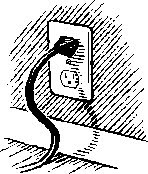My literary agent passes on articles to me (She's really helpful.) from time to time and I like to comment on them here. I do this to illustrate and quantify people's qualitative assessments. Back in February I wrote a post about electric cars and suggested that the electric generating infrastructure required should be examined very carefully. So let's do a little quantitative examination of the infrastructure required.
First, let's establish some facts. There are 17,342 electric generators in the U.S. and they have a nameplate capacity of approximately 1,000,000 Megawatts. A Megawatt equals 1,000,000 Watts or 1000 kilowatts. There are 244 Million motor vehicles in the U.S., 135 Million cars and the rest are trucks and buses.
Let's set some design criteria to size our infrastructure. First, I want my infrastructure to be built in phases. So I'm only going to design and build enough power plants, transmission lines and distribution lines to charge and power 135 Million automobiles. We'll deal with the trucks and buses later. In addition, let's size the electric car's motor and let's be realistic. A Honda Civic has a 140 horsepower engine which amounts to a 104kW electric motor. That's realistic. Phoenix Motorcars of Ontario, California provides its SUT/SUV vehicle specifications that I think are realistic. The top speed is 95 miles per hour; it can travel 100+ miles per charge; in can go 0-60 in less than 10 seconds and it requires 6.6 kilowatts for a five to six hour charge. The motor is 147 horsepower or 110 kW. Torque is 369 ft-lbs.
So how much additional power would the U.S. require to instantaneously power all of these vehicles. The utilities that provide electricity to each of us must design and build enough power stations to supply the peak load plus a reserve or capacity margin. The margin is an amount of oversupply in case power plants have an unanticipated outage and avoids blackouts. It's why power in the country is available virtually continuously.
Let's calculate the instantaneous additional power required:
135,000,000 x 6.6 kilowatts = 891,000,000 kilowatts or 891,000 Megawatts.
When one adds a 15% capacity margin, the figure increases to 1,024,650 Megawatts, doubling existing electric generating capacity in the U.S. I have personal, hands-on experience as an engineer and a banker in the construction of power plants. It is a vastly massive undertaking. The people who do it routinely in this country are unknown and unsung . . . except by me, of course, and I have high respect for them and high regard for their skill.
Of course this is an instantaneous figure. It assumes we're all plugged in at the same time. It does not account for time zones, different driving characteristics, different characteristics of the many utility service territories in the country, different size vehicles, different battery technology, and the current overall utilization rate of existing power plants, etc., but it is in the ballpark. One can argue one way or another that it's three quarters of that figure or 50% greater. But it is huge. It is extremely costly. And I haven't begun a discussion of the transmission lines, and the opposition to building them, that would be required as well.
In the next post, we'll take a look at how many power plants would be required and how much electricity renewable energy would need to generate to power the theoretical electric vehicle fleet of the future.
Sunday, April 19, 2009
Electric Cars: The Electric Infrastructure Required
Subscribe to:
Post Comments (Atom)




No comments:
Post a Comment